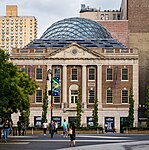W New York Union Square

The W New York Union Square is a 270-room, 21-story boutique hotel operated by W Hotels at the northeast corner of Park Avenue South and 17th Street, across from Union Square in Manhattan, New York. Originally known as the Germania Life Insurance Company Building, it was designed by Albert D'Oench and Joseph W. Yost and built in 1911 in the Beaux-Arts style. The W New York Union Square building was initially the headquarters of the Germania Life Insurance Company. In 1917, when the company became the Guardian Life Insurance Company of America, the building was renamed the Guardian Life Insurance Company Building. A four-story annex to the east was designed by Skidmore, Owings & Merrill and was completed in 1961. Guardian Life moved its offices out of the building in 1999, and the W New York Union Square opened the following year. The main building, part of the hotel, was added to the National Register of Historic Places in 2001, and was designated a city landmark by the New York City Landmarks Preservation Commission in 1988. The Guardian Life annex, not part of the current hotel, was designated as a city landmark in 2007.
Excerpt from the Wikipedia article W New York Union Square (License: CC BY-SA 3.0, Authors, Images).W New York Union Square
East 17th Street, New York Manhattan
Geographical coordinates (GPS) Address Nearby Places Show on map
Geographical coordinates (GPS)
| Latitude | Longitude |
|---|---|
| N 40.736666666667 ° | E -73.989166666667 ° |
Address
USPS
East 17th Street
10010 New York, Manhattan
New York, United States
Open on Google Maps








